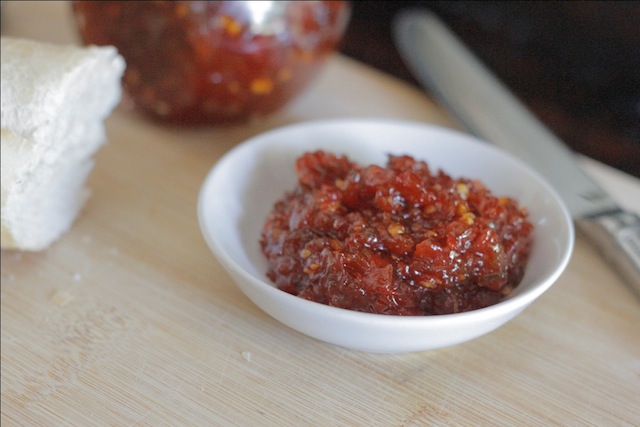SmokinEdge/JCarter93: After rereading the guide, I think it's more of the availability of acid in the product. The canning guide does appear to contradict itself when you read the canning of peppers, including jalapeno, is to be done in a pressure cooker.
The difference between the two recipes, and the listed salsa canning recipes, is in the amount of acid found in the product. When canning regular peppers, only the peppers are found in the product (low acid), requiring the use of a pressure cooker.
In the jam/ jellies/salsa recipes found in the Guide, vinegar is added to increase the available acid in the product, plus there is a LOT of product boiling!
My head hurts?! LOL! I need a glass of vinegar, I mean wine?!


John
Here is a copy of the 2018 revision to the pepper recipe referenced above.
Making Jams and Jellies
Golden Pepper Jelly
- 5 cups chopped yellow bell peppers (about 4 large fleshy peppers as purchased)
- 1/2 cup chopped Serrano chile peppers (about 5 peppers as purchased)
- 1-1/2 cups white distilled vinegar (5%)
- 5 cups sugar
- 1 pouch (3 ounces) liquid pectin
Yield: About 5 half-pint jars
Please read
Using Boiling Water Canners before beginning. If this is your first-time canning, it is recommended that you read
Principles of Home Canning.
Caution: Wear plastic or rubber gloves and do not touch your face while handling or cutting hot peppers. If you do not wear gloves, wash hands thoroughly with soap and water before touching your face or eyes.
Procedure:
1. Wash and rinse half-pint canning jars;
pre-sterilize and keep hot until ready to fill. Prepare lids and ring bands according to manufacturer's directions.
To Prepare Pepper Juice —
2. Wash all peppers thoroughly; remove stems and seeds from the peppers. Do not remove the membrane from the hot peppers, since the remaining capsaicin for pepper heat is located there.
3. Place sweet and hot peppers in a blender or food processor. Add enough vinegar to purée the peppers, then purée.
4. Combine the pepper-vinegar purée and remaining vinegar into an 8- or 10-quart saucepan. Heat to a boil; then boil 10 minutes to extract flavors and color.
5. Remove from heat and strain through a jelly bag into a bowl. (The jelly bag is preferred; several layers of cheesecloth may also be used.)
To Make Jelly —
6. Measure 2-1/4 cups of the strained pepper-vinegar juice into the 8- to 10-quart saucepan. Stir in sugar until dissolved and return mixture to a boil. Add the pectin, return to a full rolling boil and boil hard for 1 minute, stirring constantly. Remove from heat; skim off foam quickly.
7. Fill hot jelly immediately into hot, pre-sterilized half-pint jars, leaving 1/4-inch headspace. Wipe rims of jars with a dampened clean paper towel. Apply and adjust prepared lids.
8. Process filled jars in a boiling water canner according to the recommendations in
Table 1.
9. Let processed jars cool, undisturbed, 12 to 24 hours and check for vacuum seals.
| Table 1. Recommended process time for Golden Pepper Jelly in a boiling-water canner. | | | | |
| Process Time at Altitudes of | | | |
| Style of Pack | Jar Size | 0 - 1,000 ft | 1,001 - 6,000 ft | Above 6,000 ft |
| Hot | Half-pints | 5 min | 10 | 15 |
| The following optional 10-minute boiling water process can also be used and may provide a stronger vacuum in the jar. Jars would not need to be pre-sterilized, but could be washed, rinsed and kept hot until filling. | | | | |
| Hot | Half-pints | 10 min | 15 | 20 |
Notes:
(1) The use of yellow peppers gives this jelly a light golden color. Other color sweet peppers can be substituted, but these will provide a different jelly color. Other hot peppers can also be substituted. It is best to start with a mild hot pepper flavor and increase it to personal tastes.
(2) If properly prepared the jelly will have a mildly firm set. It is best to use half-pint jars.
(3) The addition of vinegar to the low-acid sweet and hot peppers makes this recipe safe for boiling water canning. Do not reduce the amount of vinegar. The amounts of vinegar and sugar are also necessary to provide the conditions required to form a gel with the added pectin.
(4) Refrigerate any leftover jelly from filling jars, if any, and enjoy freshly made. Refrigerate the jelly once sealed jars are opened for use.
Developed at The University of Georgia, Athens. Released by Elizabeth L. Andress, Ph.D., Department of Foods and Nutrition, College of Family and Consumer Sciences. May 2018.

 www.theyummytruth.com
www.theyummytruth.com





